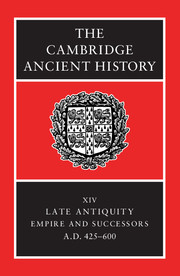Book contents
- Frontmatter
- PART I CHRONOLOGICAL OVERVIEW
- PART II GOVERNMENT AND INSTITUTIONS
- PART III EAST AND WEST: ECONOMY AND SOCIETY
- PART IV THE PROVINCES AND THE NON-ROMAN WORLD
- 18 The north-western provinces
- 19 Italy, A.D. 425–605
- 20 Vandal and Byzantine Africa
- 21a Asia Minor and Cyprus
- 21b Syria, Palestine and Mesopotamia
- 21c Egypt
- 22a The Sasanid monarchy
- 22b Armenia in the fifth and sixth century
- 22c The Arabs
- 23 The Balkans and Greece 420–602
- PART V RELIGION AND CULTURE
- Conclusion
- Chronological Table
- BIBLIOGRAPHY
- Index
- References
21a - Asia Minor and Cyprus
from PART IV - THE PROVINCES AND THE NON-ROMAN WORLD
Published online by Cambridge University Press: 28 March 2008
- Frontmatter
- PART I CHRONOLOGICAL OVERVIEW
- PART II GOVERNMENT AND INSTITUTIONS
- PART III EAST AND WEST: ECONOMY AND SOCIETY
- PART IV THE PROVINCES AND THE NON-ROMAN WORLD
- 18 The north-western provinces
- 19 Italy, A.D. 425–605
- 20 Vandal and Byzantine Africa
- 21a Asia Minor and Cyprus
- 21b Syria, Palestine and Mesopotamia
- 21c Egypt
- 22a The Sasanid monarchy
- 22b Armenia in the fifth and sixth century
- 22c The Arabs
- 23 The Balkans and Greece 420–602
- PART V RELIGION AND CULTURE
- Conclusion
- Chronological Table
- BIBLIOGRAPHY
- Index
- References
Summary
SOURCES
The literary evidence for the history of Asia Minor and Cyprus is abundant for every period, but it suffers to some extent from too much familiarity: Asia Minor and Cyprus were the homeland of so many writers and readers. There was nothing exotic about this area, the heartland of the eastern empire, and so authors felt little need to describe it; much has to be deduced from what they assume. Furthermore, the chief characteristic of Asia Minor and Cyprus in the fifth and sixth century was that they were at peace, so that there was little to recount in historical narratives. The exception, here as in other things, is Isauria, whose turbulent history in the fifth century brought it into the history of the empire.
The lack of ‘historical’ events can therefore convey a spurious air of immobility. In such a situation, the contribution of archaeological evidence is particularly important; and as the archaeology of this region in this period has developed, it has revealed more and more evidence of marked change. The majority of early excavations concentrated on city sites, and it was common for the late Roman material to be dealt with cursorily during the search for ‘more interesting’ periods. More recently, excavators have come to treat such material more attentively; moreover, since the 1950s, archaeologists have been surveying the countryside, and their work is starting to provide a more balanced picture of this very large area. Recent work on Roman defences and fortifications has also produced a great deal of evidence for the period.
- Type
- Chapter
- Information
- The Cambridge Ancient History , pp. 570 - 587Publisher: Cambridge University PressPrint publication year: 2001
References
- 1
- Cited by

